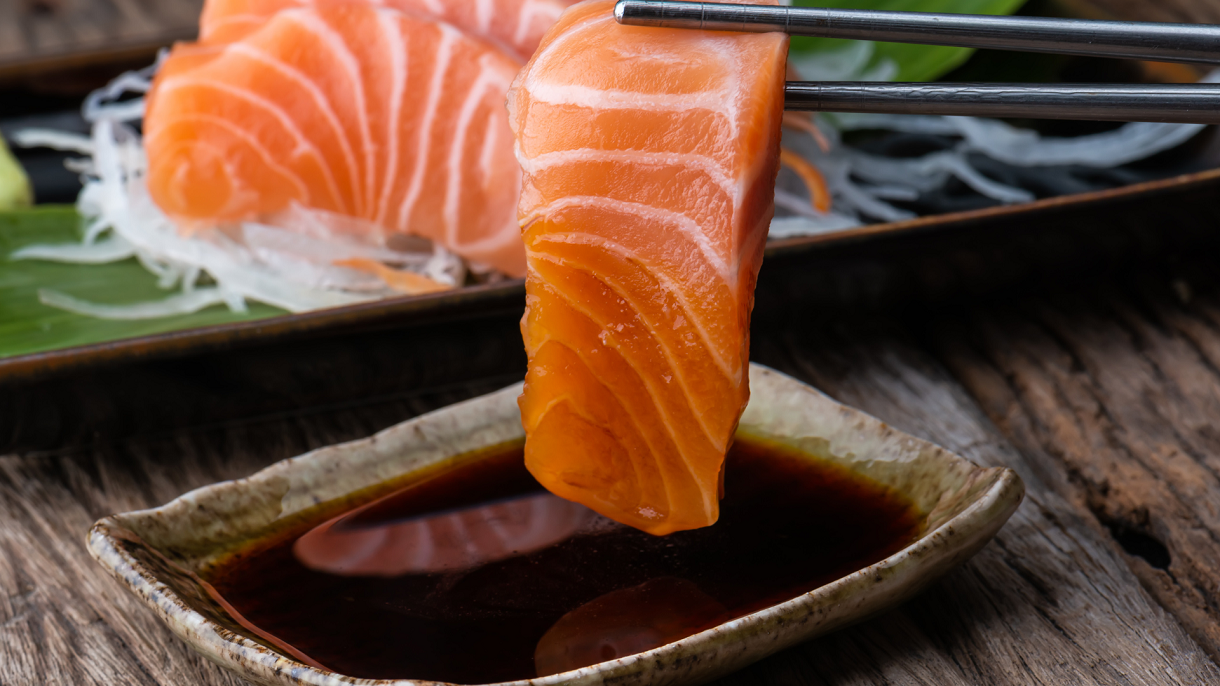Introduction:
In the realm of gastronomy, where culinary innovation meets tradition, few combinations tantalize the taste buds quite like the marriage of soy and salmon sashimi. This harmonious blend of Japanese culinary artistry and the rich, umami flavors of soy sauce creates a sensory experience that delights connoisseurs and novices alike. In this article, we delve deep into the origins, preparation techniques, health benefits, and cultural significance of this delectable dish, offering a comprehensive exploration of its allure.
Origins and Evolution:
To appreciate the significance of soy and salmon sashimi, one must first understand the origins of both components. Sashimi, a cornerstone of Japanese cuisine, traces its roots back centuries to a time when fresh fish was sliced and served raw, often with a simple accompaniment of soy sauce and wasabi. Meanwhile, soy sauce, or shoyu in Japanese, has been a staple seasoning in Asian cooking for over 2,000 years, originating in China before spreading throughout the region.
The fusion of these two culinary elements likely emerged in Japan, where the delicate, buttery texture of salmon paired effortlessly with the savory, slightly sweet notes of soy sauce. Over time, chefs refined the preparation techniques, balancing the flavors to create a dish that captivated palates worldwide. Today, soy and salmon sashimi stand as a testament to the artistry of Japanese cuisine and its ability to embrace innovation while honoring tradition.
Preparation and Presentation:
The preparation of soy and salmon sashimi is an exercise in precision and finesse. It begins with selecting the freshest, highest-quality salmon, preferably sourced from sustainable fisheries to ensure both flavor and environmental responsibility. The fish is then carefully filleted, removing any bones and skin to reveal the pristine, ruby-red flesh beneath.
Next comes the slicing—a task that requires a skilled hand and a sharp knife. The salmon is cut into thin, uniform slices, each one a testament to the chef’s expertise. These slices are arranged artfully on a serving platter, their vibrant hues contrasting beautifully with the deep, amber tones of the soy sauce.
Speaking of soy sauce, its role in this dish cannot be overstated. Made from fermented soybeans, wheat, water, and salt, soy sauce undergoes a complex aging process that imbues it with layers of flavor, ranging from salty and savory to subtly sweet. When drizzled over the delicate slices of salmon, it enhances their natural richness, adding depth and complexity to every bite.
Accompaniments such as freshly grated wasabi, pickled ginger, and thinly sliced cucumber are often served alongside soy and salmon sashimi, providing contrast and balance to the dish. Each element contributes its own unique flavor profile, creating a symphony of tastes that dance on the palate.
Health Benefits:
Beyond its exquisite flavor, soy and salmon sashimi offer a wealth of health benefits, making it a popular choice among health-conscious diners. Salmon, prized for its high omega-3 fatty acid content, is known to support heart health, reduce inflammation, and promote brain function. Additionally, it is an excellent source of protein, making it a satisfying and nutritious option for those looking to maintain a balanced diet.
Soy sauce, despite its modest appearance, also boasts impressive nutritional credentials. Rich in essential amino acids, vitamins, and minerals, soy sauce provides a concentrated dose of nutrients with each serving. Furthermore, its fermentation process produces beneficial compounds such as antioxidants and probiotics, which contribute to gut health and overall well-being.
When enjoyed together, soy and salmon sashimi form a powerhouse duo that nourishes the body and delights the senses—a testament to the synergy between culinary pleasure and nutritional value.
Cultural Significance:
In addition to its culinary merits, soy and salmon sashimi hold deep cultural significance, particularly within the context of Japanese cuisine. In Japan, food is revered not only for its taste but also for its aesthetic beauty and symbolic value. As such, the presentation of a dish is often as important as its flavor, with meticulous attention paid to every detail.
Soy and salmon sashimi exemplify this ethos, embodying the principles of simplicity, balance, and respect for nature. From the pristine slices of fish to the gleaming lacquerware on which they are served, every aspect of the dining experience is carefully considered, reflecting the Japanese concept of omotenashi, or hospitality.
Moreover, soy and salmon sashimi serve as a bridge between tradition and modernity, honoring the time honored techniques of Japanese culinary craftsmanship while embracing contemporary tastes and sensibilities. In a rapidly changing world, dishes like these serve as touchstones of cultural identity, reminding us of the timeless values that unite us across borders and generations.
Conclusion:
In the realm of culinary exploration, few journeys are as rewarding as the discovery of soy and salmon sashimi. From its humble origins to its lofty status as a global delicacy, this iconic dish encapsulates the essence of Japanese cuisine—simple yet sophisticated, traditional yet innovative. Whether enjoyed in a bustling izakaya in Tokyo or savored in the comfort of home, soy and salmon sashimi invite us to savor the moment, to appreciate the beauty of simplicity, and to celebrate the rich tapestry of flavors that unites us all.
Questions And Answer’s:
- What makes soy and salmon sashimi a unique culinary fusion?
- Soy and salmon sashimi combine the delicate texture of raw salmon with the savory richness of soy sauce, creating a harmonious blend of flavors that is both distinctive and memorable.
- How is soy sauce traditionally made, and what role does it play in soy and salmon sashimi?
- Soy sauce is traditionally made through the fermentation of soybeans, wheat, water, and salt. It undergoes a complex aging process, resulting in a condiment with layers of flavor ranging from salty and savory to subtly sweet. In soy and salmon sashimi, soy sauce enhances the natural richness of the salmon, adding depth and complexity to each bite.
- What health benefits do soy and salmon sashimi offer?
- Soy and salmon sashimi are rich in nutrients, including omega-3 fatty acids, protein, vitamins, and minerals. Salmon is known to support heart health, reduce inflammation, and promote brain function, while soy sauce provides essential amino acids and beneficial compounds such as antioxidants and probiotics, contributing to overall well-being.
- How does the presentation of soy and salmon sashimi reflect Japanese culinary traditions?
- The presentation of soy and salmon sashimi embodies the principles of simplicity, balance, and respect for nature that are central to Japanese cuisine. Meticulous attention is paid to every detail, from the pristine slices of fish to the elegant serving ware, reflecting the Japanese concept of omotenashi, or hospitality.
- What cultural significance does soy and salmon sashimi hold?
- Soy and salmon sashimi serve as a bridge between tradition and modernity, honoring the time-honored techniques of Japanese culinary craftsmanship while embracing contemporary tastes and sensibilities. They are symbols of cultural identity, reminding us of the timeless values that unite us across borders and generations.

